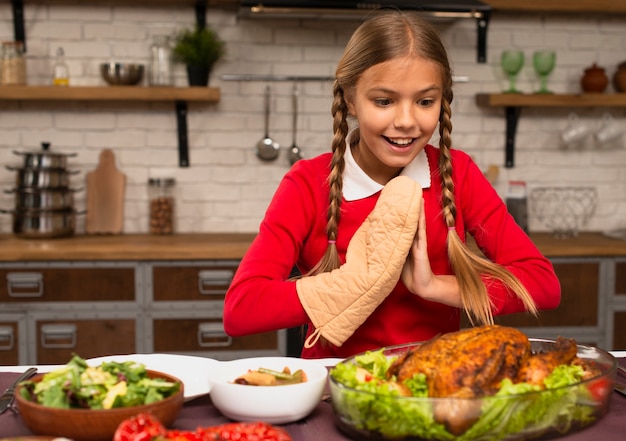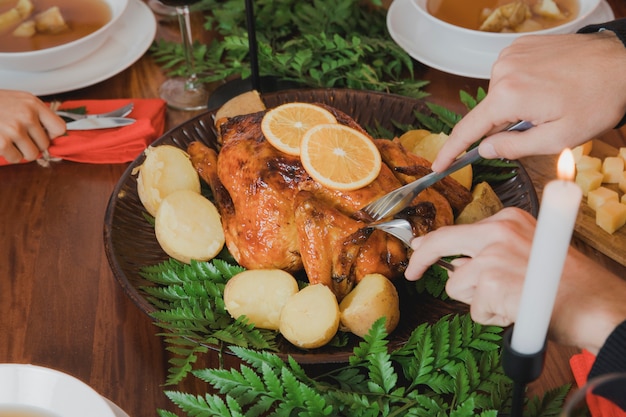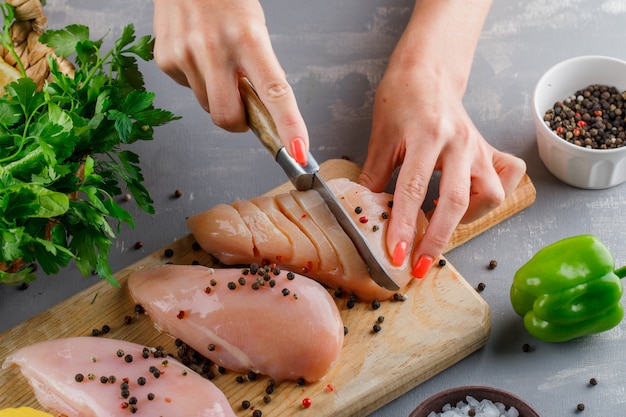Let's be honest, there's nothing quite like a juicy, tender, perfectly cooked piece of chicken. It's a versatile protein that can be the star of countless dishes, from simple weeknight dinners to elegant feasts. But let's face it, we've all had our fair share of dry, rubbery chicken nightmares. That's why I'm here to share my ultimate guide, packed with tips, tricks, and tried-and-true methods to help you master the art of cooking chicken, ensuring you never encounter a disappointing piece again.
Part 1: Choosing the Right Chicken

The journey to delicious chicken starts with selecting the right bird. Trust me, this decision is crucial for achieving those mouthwatering results.
1.1: Understanding the Chicken Hierarchy
Let's break down the different types of chicken you'll encounter:
Free-Range: These chickens live a charmed life, roaming freely and enjoying a natural diet. This often translates into a richer flavour and a more tender texture, but it comes at a premium price.
Organic: Similar to free-range, organic chickens are raised without antibiotics or hormones and are fed organic feed. They offer a slightly more subdued flavour than free-range but are still a good choice for quality and ethical reasons.
Standard Supermarket Chicken: The most readily available option, these chickens are perfectly fine for most recipes. Just ensure it's fresh or properly defrosted.
frozen chicken: Don't dismiss frozen chicken! It can be just as delicious as fresh, especially if you're working with a budget. Just make sure to defrost it properly before cooking.
1.2: Deciphering the Cuts: whole chicken, Pieces, and Breasts
Once you've decided on the type of chicken, you need to choose the right cut:
Whole Chicken: This is the whole bird, perfect for roasting and yielding enough meat for a crowd.
chicken pieces: Individual parts of the chicken, like legs, thighs, breasts, or wings, offering versatility for grilling, frying, or baking.
chicken breast: The most popular cut, ideal for grilling, baking, or stir-frying, but often requires careful cooking to avoid dryness.
1.3: A Freshness Check
Now, let's ensure your chicken is fresh and ready for cooking:
Skin: Look for smooth, plump skin that's free from blemishes or discoloration.
Smell: A fresh chicken should have a slightly sweet, clean aroma. Avoid any sour or unpleasant smells.
Texture: The meat should be firm and springy to the touch. Avoid any mushy or slimy areas.
1.4: Defrosting Frozen Chicken: The Safe and Effective Way
If you're working with frozen chicken, proper defrosting is essential:
Refrigerator Defrosting: The safest and most recommended method, allowing for gradual and even defrosting. Simply transfer the frozen chicken to the refrigerator overnight.
Cold Water Defrosting: Submerge the sealed frozen chicken in a bowl of cold water, changing the water every 30 minutes. This method is quicker but requires careful monitoring to prevent bacterial growth.
Microwave Defrosting: A quick solution in a pinch, but it can result in uneven thawing and potentially cook some areas before others. Cook immediately after defrosting using this method.
Part 2: Preparing Your Chicken for Success

Now that you've got your perfect chicken, it's time to prepare it for cooking.
2.1: Cleaning and Patting Dry: A Crucial Step
Rinse the chicken thoroughly under cold running water to remove any debris. Then, pat it dry with paper towels to remove excess moisture. This step is crucial for achieving a crispy skin and preventing steaming during cooking.
2.2: Seasoning Like a Pro: The Art of Flavor
Seasoning is where your creativity comes in, so experiment and find what you love. Salt and pepper are always a good starting point, but don't be afraid to explore beyond the basics.
Here are a few of my favourite seasoning combinations:
Herbed Chicken: Fresh rosemary, thyme, and garlic are a classic combination that adds depth and complexity.
Spicy Chicken: Cayenne pepper, paprika, and cumin will give your chicken a fiery kick.
Citrus Chicken: Lemon or lime zest adds a bright, refreshing touch.
2.3: Marination Magic: Taking Flavor to the Next Level
Marinades infuse chicken with incredible flavour and tenderness, and it's a technique I highly recommend. It's all about soaking the chicken in a flavorful liquid for a designated period, allowing the flavours to penetrate the meat.
Here are a few marinade ideas to get you started:
Citrus Marinade: Combine lemon or lime juice with olive oil, fresh herbs like rosemary or thyme, and a pinch of salt and pepper.
Soy Sauce Marinade: A blend of soy sauce, ginger, garlic, a touch of honey, and a sprinkle of black pepper creates a savory and slightly sweet marinade.
Yogurt Marinade: Perfect for tandoori chicken, this marinade combines yogurt with turmeric, garam masala, and a pinch of chili powder for a vibrant and flavorful experience.
Part 3: Mastering cooking techniques

Now that your chicken is prepped, let's delve into the various cooking techniques.
3.1: Roasting for Juicy Perfection: A Classic Technique
Roasting is a beloved method that delivers consistently juicy results with a beautifully golden-brown skin.
Preheat Your Oven: Preheat your oven to a high temperature (around 200°C or 400°F) to encourage crispy skin.
Seasoning and Placement: Rub the chicken with your chosen seasonings, olive oil, and any additional flavourings. Place the chicken in a roasting pan, ensuring it has enough space to cook evenly.
Don't Overcook: The key to moist, tender chicken is avoiding overcooking. Use a meat thermometer to check for doneness. The internal temperature should reach 74°C or 165°F.
Rest for Juiciness: After roasting, allow the chicken to rest for 10-15 minutes before carving. This allows the juices to redistribute, resulting in a more tender and flavorful bird.
3.2: Grilling for Smoky Flavour: A Summertime Delight
grilling chicken infuses it with a delicious smoky flavour, perfect for warm weather grilling.
Prepare Your Grill: Make sure your grill is clean and preheated to medium-high heat.
Grill Time: Cook the chicken for 4-5 minutes per side, or until it reaches an internal temperature of 74°C or 165°F. Turn it occasionally for even cooking.
Doneness Check: Use a meat thermometer to ensure the chicken is cooked through.
3.3: Pan-Frying for quick and easy meals: Weeknight Saviors
Pan-frying is a fast and straightforward method for weeknight dinners.
Heat Your Pan: Use a heavy-bottomed pan and heat it over medium-high heat. Add a tablespoon or two of oil to the pan and let it shimmer before adding the chicken.
cooking time: Cook the chicken for 4-5 minutes per side, or until it's golden brown and cooked through.
Avoid Overcrowding: Don't overcrowd the pan as this will hinder even cooking and potentially lead to steaming instead of browning.
3.4: Baking for Tender and Juicy Results: A Reliable Option
Baking is a reliable method for achieving consistently tender and juicy chicken breasts and thighs.
Preheat Your Oven: Set your oven to 180°C or 350°F.
Baking Time: Place the chicken in a baking dish and bake for 20-25 minutes, or until it reaches an internal temperature of 74°C or 165°F.
Doneness Check: Use a meat thermometer to ensure the chicken is cooked through.
3.5: Don't Fear the Microwaving!: A Time-Saving Solution
Yes, you can cook chicken in the microwave! While not ideal for achieving the same flavour and texture as other methods, it can be a lifesaver when you're short on time.
Microwave Time: Cook your chicken on high for 5-7 minutes per pound.
Doneness Check: Ensure the chicken is cooked through before serving.
Cover to Prevent Splatter: Use a microwave-safe lid to prevent splatter.
Part 4: Avoiding Dry Chicken Disasters: Preventing the Rubberiness
Let's address the dreaded dry chicken woes and ensure you never encounter another rubbery piece again.
4.1: The Importance of Internal Temperature: The Key to Juiciness
Overcooking is a major culprit for dry chicken, so using a meat thermometer is essential. Aim for an internal temperature of 74°C or 165°F for perfectly cooked chicken.
4.2: Don't Overcrowd the Pan: Even Cooking is Key
Overcrowding the pan during pan-frying or baking hinders even cooking and can lead to steaming instead of browning. Ensure your chicken pieces have enough space to cook properly.
4.3: Keep an Eye on the Heat: The Right Temperature Matters
Too much heat can dry out chicken quickly. During roasting or grilling, monitor the heat and adjust it as needed.
4.4: Rest the Chicken: Allowing Juices to Redistribute
After cooking, allow the chicken to rest for 10-15 minutes before carving. This allows the juices to redistribute throughout the meat, resulting in a more tender and flavorful result.
Part 5: Chicken Hacks and Tips: Taking Your Cooking to the Next Level
Here are some clever tips and tricks to elevate your chicken cooking skills.
5.1: The Brine Solution: Unlocking juicy chicken
Brining involves soaking the chicken in a salt solution for a few hours before cooking. It's a simple technique that helps retain moisture and enhance the flavour.
Brine Recipe: Combine water with salt, sugar (optional), and any additional herbs or spices you like. Submerge the chicken in the brine, ensuring it's completely covered, and refrigerate for 2-4 hours.
5.2: The Baking Sheet Trick: Preventing Spatter and Mess
To avoid splattering while roasting chicken, place a baking sheet beneath the roasting pan. This will catch any drips and make cleanup a breeze.
5.3: The Skin-on Advantage: For Crispy Skin and Flavor
If you're roasting chicken, keeping the skin on helps retain moisture and creates a wonderfully crispy texture.
5.4: The instant pot Miracle: Fast and Easy Chicken
An Instant Pot is a pressure cooker that can cook chicken perfectly in a fraction of the time. It's a convenient option for quick and easy meals.
5.5: The Leftover Chicken Revival: Making the Most of Leftovers
Don't let leftover chicken go to waste! It's a great base for soups, salads, sandwiches, or even pizza toppings.
Part 6: Delicious chicken recipes: Putting Your Skills to the Test
Now, let's put those cooking skills into action with some delicious chicken recipes.
6.1: Classic roast chicken with Herbs
This is a timeless classic that delivers juicy, flavorful chicken.
Ingredients:
1 whole chicken (about 1.5 kg or 3 lbs)
2 tablespoons olive oil
1 tablespoon salt
1 teaspoon black pepper
1 teaspoon dried rosemary
1 teaspoon dried thyme
1 clove garlic, minced
Instructions:
Preheat oven to 200°C or 400°F.
Pat the chicken dry with paper towels.
Rub the chicken with olive oil, salt, pepper, rosemary, thyme, and garlic.
Place the chicken in a roasting pan.
Roast for 1 hour and 15 minutes, or until the internal temperature reaches 74°C or 165°F.
Let the chicken rest for 10-15 minutes before carving.
6.2: Grilled Lemon Herb Chicken
This recipe offers a light and refreshing taste perfect for summertime grilling.
Ingredients:
4 boneless, skinless chicken breasts
1 tablespoon olive oil
1 tablespoon lemon juice
1 teaspoon dried oregano
1 teaspoon dried basil
1/2 teaspoon salt
1/4 teaspoon black pepper
Instructions:
In a small bowl, whisk together olive oil, lemon juice, oregano, basil, salt, and pepper.
Place the chicken breasts in a shallow dish and pour the marinade over them.
Marinate for at least 30 minutes, or up to 2 hours.
Preheat grill to medium-high heat.
Grill the chicken for 4-5 minutes per side, or until cooked through.
6.3: pan-fried chicken with Garlic and Lemon
This quick and flavorful recipe is ideal for weeknight dinners.
Ingredients:
4 boneless, skinless chicken breasts
2 tablespoons olive oil
4 cloves garlic, minced
1/4 cup lemon juice
1/4 cup chopped fresh parsley
1/2 teaspoon salt
1/4 teaspoon black pepper
Instructions:
Heat the olive oil in a large skillet over medium-high heat.
Season the chicken breasts with salt and pepper.
Add the chicken to the skillet and cook for 4-5 minutes per side, or until golden brown and cooked through.
Remove the chicken from the skillet and set aside.
Add the garlic to the skillet and cook for 1 minute, or until fragrant.
Stir in the lemon juice and parsley.
Return the chicken to the skillet and cook for 1 minute, or until heated through.
6.4: Baked Chicken with Dijon Mustard and Herbs
This recipe delivers a flavourful and tender chicken thanks to the Dijon mustard marinade.
Ingredients:
4 boneless, skinless chicken breasts
2 tablespoons olive oil
2 tablespoons Dijon mustard
1 teaspoon dried rosemary
1 teaspoon dried thyme
1/2 teaspoon salt
1/4 teaspoon black pepper
Instructions:
Preheat oven to 180°C or 350°F.
In a small bowl, whisk together olive oil, Dijon mustard, rosemary, thyme, salt, and pepper.
Place the chicken breasts in a baking dish and pour the marinade over them.
Bake for 20-25 minutes, or until cooked through.
Part 7: Chicken and Sides: A Perfect Pairing
Your chicken deserves the perfect accompaniment.
7.1: Starchy Companions: Complementary Textures and Flavors
Roasted Potatoes: A classic pairing for roasted chicken, offering a crispy texture and hearty flavour.
mashed potatoes: Cream and comforting, a perfect side for any chicken dish.
Rice: Versatile and adaptable, rice can be seasoned with herbs, spices, or citrus for a flavourful side.
Pasta: A great choice for a hearty chicken dish, with options like creamy sauces or a simple tomato sauce.
7.2: Fresh and Green: Adding Vibrancy and Balance
Salad: A classic side that can be customized with your favourite toppings, from leafy greens to colourful vegetables and protein sources.
green beans: A simple and healthy option, perfect for steaming or roasting.
Asparagus: A springy and delicious side that adds a touch of elegance to your meal.
Broccoli: A nutrient-rich option, fantastic for grilling or roasting.
7.3: The Sweet and Savoury Balance: Elevating Your Chicken Dish
fruit salad: A refreshing and colourful side, especially with sweet and tart fruits like berries and grapes.
Applesauce: A classic pairing for roasted chicken, offering a touch of sweetness and a complementary flavour.
sweet potato Casserole: A comforting and delicious side, perfect for a hearty meal.
Part 8: FAQs
Let's address some frequently asked questions about cooking chicken.
8.1: How Long Can I Keep Chicken in the Fridge?
Raw chicken can be safely stored in the refrigerator for up to 2 days. If you're unsure about its freshness, it's best to err on the side of caution and discard it.
8.2: How Can I Tell if Chicken is Cooked Through?
Use a meat thermometer to accurately check the internal temperature. It should reach 74°C or 165°F for safe consumption. You can also check if the juices run clear when you cut into the chicken.
8.3: What Should I Do with Leftover Chicken?
Leftover chicken is a versatile ingredient! It's great for soups, salads, sandwiches, or even pizza toppings.
8.4: Can I Freeze Chicken?
Yes, you can freeze chicken for up to 2 months. It's best to freeze it in a freezer-safe bag or container, labeled with the date.
8.5: What Are Some Tips for Cooking Chicken for Children?
Ensure the chicken is cooked through and that any bones are removed for safety. Cut the chicken into smaller pieces, making it easier for little hands to eat.
There you have it, my friends! Your ultimate guide to cooking perfect chicken every time. Remember, practice makes perfect. Experiment, have fun, and most importantly, enjoy the delicious results!
Everyone is watching

How to Cook Frozen Lobster Tails Perfectly: A Step-by-Step Guide
RecipesLobster. Just the word conjures up images of lavish meals, special occasions, and a taste of luxury. But let's...

Pigs in a Blanket Cooking Time: How Long to Bake for Perfect Results
RecipesAh, pigs in a blanket. Just the name conjures up images of those delightful little parcels of crispy pastry en...

Pork Fillet Cooking Time: How Long to Cook It Perfectly
RecipesPork fillet, or tenderloin as it's sometimes called, is a real favourite in our house. It's so versatile, and...

The Ultimate Guide to Tender, Juicy Pulled Pork
RecipesRight, let's talk pulled pork. It's one of those dishes that just screams "comfort food," doesn't it? I mean...

The Ultimate Guide to Cooking Sweet Potatoes: From Roasting to Mashing
RecipesSweet potatoes. Just the name conjures up images of warm, comforting dishes, bursts of vibrant color, and a to...
